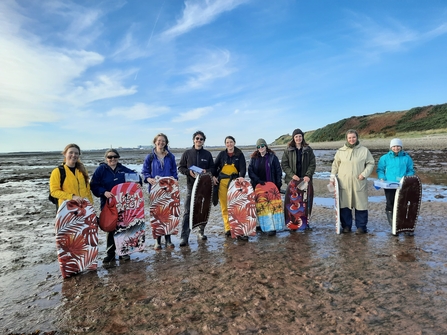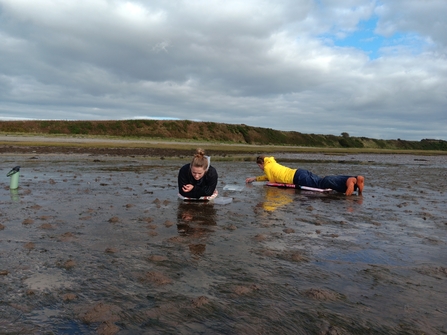
Volunteers about to collect seagrass seeds in the Walney Channel © Cumbria Wildlife Trust

Volunteers about to collect seagrass seeds in the Walney Channel © Cumbria Wildlife Trust
Two of our Irish Sea coast conservationists have received an award for a project which has carried out outstanding work to protect and restore the precious seagrass beds in the Walney Channel near Barrow.
Amber Gould and Beth Churn, Marine Conservation Officers with Cumbria Wildlife Trust, were presented with the Coastal Best Practice award (part of the North West Awards for Coastal Excellence) for the project, at a recent conference run by the North West Coastal Forum.
Amber and Beth said: “Thank you very much to those who nominated and selected us for this award - it really means a lot to be recognised for the work that's gone into this project. We'd like to share the award with everyone who has given their time and energy to volunteer as part of the seagrass restoration efforts and to those who provided invaluable expertise and guidance - we couldn't do it without you!”

Left to right: Amber Gould, Georgia de Jong Cleyndert and Beth Churn with Coastal Best Practice Award for seagrass restoration
Amber and Beth have been running the seagrass restoration project in the Walney Channel for the past two years. Following extensive surveying of the existing seagrass beds, they then trained volunteers who are now helping them to restore the seagrass, by transplanting seeds from healthy sites to places where the seagrass has been lost.
Seagrass beds can provide protection to coastal communities by stabilising the sand and mud with their roots. They act as a ‘blue carbon’ habitat, removing carbon from the atmosphere and locking it away in plants and mud, and provide an important habitat for marine life, including commercially-important fish and critically-endangered species.
However, the UK has lost 90% of all seagrass beds over the last century and in Morecambe Bay, around 70% has been lost. Recent surveys show that around 70ha (127 acres) of seagrass remains in the Walney Channel - that’s around the size of 63 football pitches.
It's hoped that the current seagrass restoration work by Amber, Beth and their volunteers will eventually boost that number and bring back some of the lost areas of seagrass in the Walney Channel.

Lying on bodyboards to collect seagrass seeds, so as not to disturb the seagrass beds © Cumbria Wildlife Trust